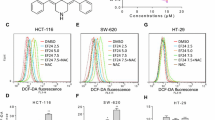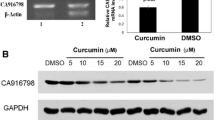Abstract
Cancer cells require higher levels of ATP for their sustained growth, proliferation, and chemoresistance. Mitochondrial matrix protein, C1qbp is upregulated in colon cancer cell lines. It protects the mitochondria from oxidative stress, by inhibiting the Membrane Permeability Transition (MPT) pore and providing uninterrupted synthesis of ATP. This intracellular interaction of C1qbp could be involved in chemoresistance development. Natural chemosensitizing agent, curcumin has been used in the treatment of multiple cancers. In this current study, we elucidate the role of C1qbp during curcumin induced chemosensitization to doxorubicin resistant colon cancer cells. The possible interaction between C1qbp and curcumin was determined using bioinformatics tools—AutoDock, SYBYL, and PyMol. Intracellular doxorubicin accumulation by fluorimetry and dead cell count was carried out to determine development of chemoresistance. Effect of curcumin treatment and cytotoxicity was measured by MTT and lactate dehydrogenase release. Morphological analysis by phase contrast microscopy and colony forming ability by colonogenic assay were also performed. In addition, Cox-2 could mediate P-glycoprotein upregulation via phosphorylation of c-Jun. Thus, the gene level expression of P-glycoprotein and Cox-2 was also investigated using PCR. Through molecular docking we identified possible interaction between curcumin and C1qbp. We observed development of chemoresistance upon 6th day treatment. Concentration dependent alleviation of chemoresistance development by curcumin was confirmed and was found to reduce gene level expression of P-glycoprotein and Cox-2. Hence, curcumin could interact directly with C1qbp protein and this interaction could contribute to the chemosensiting effect to doxorubicin in colon cancer cells.





Similar content being viewed by others
Data availability
Yes, can be furnished upon requirement.
References
Jiang J, Zhang Y, Krainer AR, Xu RM (1999) Crystal structure of human p32, a doughnut-shaped acidic mitochondrial matrix protein. Proc Natl Acad Sci USA 96(7):3572–3577. https://doi.org/10.1073/pnas.96.7.3572
Dedio J, Jahnen-Dechent W, Bachmann M, Muller-Esterl W (1998) The multiligand-binding protein gC1qR, putative C1q receptor, is a mitochondrial protein. J Immunol 160(7):3534–3542
Eggleton P, Tenner AJ, Reid KB (2000) C1q receptors. Clin Exp Immunol 120(3):406–412
Barna J, Dimen D, Puska G, Kovacs D, Csikos V, Olah S, Udvari EB, Pal G, Dobolyi A (2019) Complement component 1q subcomponent binding protein in the brain of the rat. Sci Rep 9(1):4597. https://doi.org/10.1038/s41598-019-40788-z
Fogal V, Richardson AD, Karmali PP, Scheffler IE, Smith JW, Ruoslahti E (2010) Mitochondrial p32 protein is a critical regulator of tumor metabolism via maintenance of oxidative phosphorylation. Mol Cell Biol 30(6):1303–1318. https://doi.org/10.1128/MCB.01101-09
Fogal V, Zhang L, Krajewski S, Ruoslahti E (2008) Mitochondrial/cell-surface protein p32/gC1qR as a molecular target in tumor cells and tumor stroma. Cancer Res 68(17):7210–7218. https://doi.org/10.1158/0008-5472.CAN-07-6752
Scully OJ, Yu Y, Salim A, Thike AA, Yip GW, Baeg GH, Tan PH, Matsumoto K, Bay BH (2015) Complement component 1, q subcomponent binding protein is a marker for proliferation in breast cancer. Exp Biol Med (Maywood) 240(7):846–853. https://doi.org/10.1177/1535370214565075
Elrod JW, Molkentin JD (2013) Physiologic functions of cyclophilin D and the mitochondrial permeability transition pore. Circ J 77(5):1111–1122
McGee AM, Baines CP (2011) Complement 1q-binding protein inhibits the mitochondrial permeability transition pore and protects against oxidative stress-induced death. Biochem J 433(1):119–125. https://doi.org/10.1042/BJ20101431
McGee AM, Douglas DL, Liang Y, Hyder SM, Baines CP (2011) The mitochondrial protein C1qbp promotes cell proliferation, migration and resistance to cell death. Cell Cycle 10(23):4119–4127. https://doi.org/10.4161/cc.10.23.18287
Tewey KM, Rowe TC, Yang L, Halligan BD, Liu LF (1984) Adriamycin-induced DNA damage mediated by mammalian DNA topoisomerase II. Science 226(4673):466–468
Wang S, Kotamraju S, Konorev E, Kalivendi S, Joseph J, Kalyanaraman B (2002) Activation of nuclear factor-kappaB during doxorubicin-induced apoptosis in endothelial cells and myocytes is pro-apoptotic: the role of hydrogen peroxide. Biochem J 367(Pt 3):729–740. https://doi.org/10.1042/BJ20020752
Cutts SM, Nudelman A, Rephaeli A, Phillips DR (2005) The power and potential of doxorubicin-DNA adducts. IUBMB Life 57(2):73–81. https://doi.org/10.1080/15216540500079093
Bracci L, Schiavoni G, Sistigu A, Belardelli F (2014) Immune-based mechanisms of cytotoxic chemotherapy: implications for the design of novel and rationale-based combined treatments against cancer. Cell Death Differ 21(1):15–25. https://doi.org/10.1038/cdd.2013.67
Yang F, Teves SS, Kemp CJ (1845) Henikoff S (2014) Doxorubicin, DNA torsion, and chromatin dynamics. Biochim Biophys Acta 1:84–89. https://doi.org/10.1016/j.bbcan.2013.12.002
Gammella E, Maccarinelli F, Buratti P, Recalcati S, Cairo G (2014) The role of iron in anthracycline cardiotoxicity. Front Pharmacol 5:25. https://doi.org/10.3389/fphar.2014.00025
Octavia Y, Tocchetti CG, Gabrielson KL, Janssens S, Crijns HJ, Moens AL (2012) Doxorubicin-induced cardiomyopathy: from molecular mechanisms to therapeutic strategies. J Mol Cell Cardiol 52(6):1213–1225. https://doi.org/10.1016/j.yjmcc.2012.03.006
Weeks JC, Catalano PJ, Cronin A, Finkelman MD, Mack JW, Keating NL, Schrag D (2012) Patients' expectations about effects of chemotherapy for advanced cancer. N Engl J Med 367(17):1616–1625. https://doi.org/10.1056/NEJMoa1204410
Bose D, Zimmerman LJ, Pierobon M, Petricoin E, Tozzi F, Parikh A, Fan F, Dallas N, Xia L, Gaur P, Samuel S, Liebler DC, Ellis LM (2011) Chemoresistant colorectal cancer cells and cancer stem cells mediate growth and survival of bystander cells. Br J Cancer 105(11):1759–1767. https://doi.org/10.1038/bjc.2011.449
Tang XQ, Bi H, Feng JQ, Cao JG (2005) Effect of curcumin on multidrug resistance in resistant human gastric carcinoma cell line SGC7901/VCR. Acta Pharmacol Sin 26(8):1009–1016. https://doi.org/10.1111/j.1745-7254.2005.00149.x
Toden S, Okugawa Y, Jascur T, Wodarz D, Komarova NL, Buhrmann C, Shakibaei M, Boland CR, Goel A (2015) Curcumin mediates chemosensitization to 5-fluorouracil through miRNA-induced suppression of epithelial-to-mesenchymal transition in chemoresistant colorectal cancer. Carcinogenesis 36(3):355–367. https://doi.org/10.1093/carcin/bgv006
Huang YF, Zhu DJ, Chen XW, Chen QK, Luo ZT, Liu CC, Wang GX, Zhang WJ, Liao NZ (2017) Curcumin enhances the effects of irinotecan on colorectal cancer cells through the generation of reactive oxygen species and activation of the endoplasmic reticulum stress pathway. Oncotarget 8(25):40264–40275. https://doi.org/10.18632/oncotarget.16828
Wen C, Fu L, Huang J, Dai Y, Wang B, Xu G, Wu L, Zhou H (2019) Curcumin reverses doxorubicin resistance via inhibition the efflux function of ABCB4 in doxorubicinresistant breast cancer cells. Mol Med Rep 19(6):5162–5168. https://doi.org/10.3892/mmr.2019.10180
Morin D, Barthelemy S, Zini R, Labidalle S, Tillement JP (2001) Curcumin induces the mitochondrial permeability transition pore mediated by membrane protein thiol oxidation. FEBS Lett 495(1–2):131–136
Liu Z, Duan ZJ, Chang JY, Zhang ZF, Chu R, Li YL, Dai KH, Mo GQ, Chang QY (2014) Sinomenine sensitizes multidrug-resistant colon cancer cells (Caco-2) to doxorubicin by downregulation of MDR-1 expression. PLoS ONE 9(6):e98560. https://doi.org/10.1371/journal.pone.0098560
Riganti C, Miraglia E, Viarisio D, Costamagna C, Pescarmona G, Ghigo D, Bosia A (2005) Nitric oxide reverts the resistance to doxorubicin in human colon cancer cells by inhibiting the drug efflux. Cancer Res 65(2):516–525
Bradford MM (1976) A rapid and sensitive method for the quantitation of microgram quantities of protein utilizing the principle of protein-dye binding. Anal Biochem 72:248–254
Sivalingam N, Basivireddy J, Pulimood AB, Balasubramanian KA, Jacob M (2009) Activation of phospholipase A2 is involved in indomethacin-induced damage in Caco-2 cells. Toxicol In Vitro 23(5):887–896. https://doi.org/10.1016/j.tiv.2009.05.008
Mosmann T (1983) Rapid colorimetric assay for cellular growth and survival: application to proliferation and cytotoxicity assays. J Immunol Methods 65(1–2):55–63. https://doi.org/10.1016/0022-1759(83)90303-4
Franken NA, Rodermond HM, Stap J, Haveman J, van Bree C (2006) Clonogenic assay of cells in vitro. Nat Protoc 1(5):2315–2319. https://doi.org/10.1038/nprot.2006.339
Zhang X, Zhang F, Guo L, Wang Y, Zhang P, Wang R, Zhang N, Chen R (2013) Interactome analysis reveals that C1QBP (complement component 1, q subcomponent binding protein) is associated with cancer cell chemotaxis and metastasis. Mol Cell Proteomics 12(11):3199–3209. https://doi.org/10.1074/mcp.M113.029413
Kim K, Kim MJ, Kim KH, Ahn SA, Kim JH, Cho JY, Yeo SG (2017) C1QBP is upregulated in colon cancer and binds to apolipoprotein A-I. Exp Ther Med 13(5):2493–2500. https://doi.org/10.3892/etm.2017.4249
Chen R, Xiao M, Gao H, Chen Y, Li Y, Liu Y, Zhang N (2016) Identification of a novel mitochondrial interacting protein of C1QBP using subcellular fractionation coupled with CoIP-MS. Anal Bioanal Chem 408(6):1557–1564. https://doi.org/10.1007/s00216-015-9228-7
Shi H, Fang W, Liu M, Fu D (2017) Complement component 1, q subcomponent binding protein (C1QBP) in lipid rafts mediates hepatic metastasis of pancreatic cancer by regulating IGF-1/IGF-1R signaling. Int J Cancer 141(7):1389–1401. https://doi.org/10.1002/ijc.30831
Kim KB, Yi JS, Nguyen N, Lee JH, Kwon YC, Ahn BY, Cho H, Kim YK, Yoo HJ, Lee JS, Ko YG (2011) Cell-surface receptor for complement component C1q (gC1qR) is a key regulator for lamellipodia formation and cancer metastasis. J Biol Chem 286(26):23093–23101. https://doi.org/10.1074/jbc.M111.233304
Wang Y, Fu D, Su J, Chen Y, Qi C, Sun Y, Niu Y, Zhang N, Yue D (2017) C1QBP suppresses cell adhesion and metastasis of renal carcinoma cells. Sci Rep 7(1):999. https://doi.org/10.1038/s41598-017-01084-w
Yue D, Wang Y, Sun Y, Niu Y, Chang C (2017) C1QBP regulates YBX1 to suppress the androgen receptor (AR)-enhanced RCC cell invasion. Neoplasia 19(2):135–144. https://doi.org/10.1016/j.neo.2016.12.003
Rozanov DV, Ghebrehiwet B, Ratnikov B, Monosov EZ, Deryugina EI, Strongin AY (2002) The cytoplasmic tail peptide sequence of membrane type-1 matrix metalloproteinase (MT1-MMP) directly binds to gC1qR, a compartment-specific chaperone-like regulatory protein. FEBS Lett 527(1–3):51–57
Romiti N, Tongiani R, Cervelli F, Chieli E (1998) Effects of curcumin on P-glycoprotein in primary cultures of rat hepatocytes. Life Sci 62(25):2349–2358. https://doi.org/10.1016/s0024-3205(98)00216-1
Mapoung S, Pitchakarn P, Yodkeeree S, Ovatlarnporn C, Sakorn N, Limtrakul P (2016) Chemosensitizing effects of synthetic curcumin analogs on human multi-drug resistance leukemic cells. Chem Biol Interact 244:140–148. https://doi.org/10.1016/j.cbi.2015.12.001
Gao L, Zhao P, Li Y, Yang D, Hu P, Li L, Cheng Y, Yao H (2020) Reversal of PGlycoprotein-mediated multidrug resistance by novel curcumin analogues in paclitaxel-resistant human breast cancer cells. Biochem Cell Biol. https://doi.org/10.1139/bcb-2019-0377
Yang L, Li D, Tang P, Zuo Y (2020) Curcumin increases the sensitivity of K562/DOX cells to doxorubicin by targeting S100 calcium-binding protein A8 and P-glycoprotein. Oncol Lett 19(1):83–92. https://doi.org/10.3892/ol.2019.11083
Junkun L, Erfu C, Tony H, Xin L, Sudeep KC, Mingliang Z, Yanqin W, XiangQian Q (2016) Curcumin downregulates phosphate carrier and protects against doxorubicin induced cardiomyocyte apoptosis. Biomed Res Int 2016:1980763. https://doi.org/10.1155/2016/1980763
Tefas LR, Sylvester B, Tomuta I, Sesarman A, Licarete E, Banciu M, Porfire A (2017) Development of antiproliferative long-circulating liposomes co-encapsulating doxorubicin and curcumin, through the use of a quality-by-design approach. Drug Des Dev Ther 11:1605–1621. https://doi.org/10.2147/DDDT.S129008
Gu Y, Li J, Li Y, Song L, Li D, Peng L, Wan Y, Hua S (2016) Nanomicelles loaded with doxorubicin and curcumin for alleviating multidrug resistance in lung cancer. Int J Nanomed 11:5757–5770. https://doi.org/10.2147/IJN.S118568
Patel VA, Dunn MJ, Sorokin A (2002) Regulation of MDR-1 (P-glycoprotein) by cyclooxygenase-2. J Biol Chem 277(41):38915–38920. https://doi.org/10.1074/jbc.M206855200
Steinbach G, Lynch PM, Phillips RK, Wallace MH, Hawk E, Gordon GB, Wakabayashi N, Saunders B, Shen Y, Fujimura T, Su LK, Levin B, Godio L, Patterson S, Rodriguez-Bigas MA, Jester SL, King KL, Schumacher M, Abbruzzese J, DuBois RN, Hittelman WN, Zimmerman S, Sherman JW, Kelloff G (2000) The effect of celecoxib, a cyclooxygenase-2 inhibitor, in familial adenomatous polyposis. N Engl J Med 342(26):1946–1952. https://doi.org/10.1056/NEJM200006293422603
Sui H, Zhou S, Wang Y, Liu X, Zhou L, Yin P, Fan Z, Li Q (2011) COX-2 contributes to P-glycoprotein-mediated multidrug resistance via phosphorylation of c-Jun at Ser63/73 in colorectal cancer. Carcinogenesis 32(5):667–675. https://doi.org/10.1093/carcin/bgr016
Ratnasinghe D, Daschner PJ, Anver MR, Kasprzak BH, Taylor PR, Yeh GC, Tangrea JA (2001) Cyclooxygenase-2, P-glycoprotein-170 and drug resistance; is chemoprevention against multidrug resistance possible? Anticancer Res 21(3C):2141–2147
Acknowledgements
The authors would like to acknowledge the Department of Biotechnology, School of Bioengineering, College of Engineering and Technology, Faculty of Engineering and Technology, SRM Institute of Science and Technology, Kattankulathur-603203, Tamil Nadu, India, for the financial support.
Author information
Authors and Affiliations
Contributions
NS conceived the project and designed the experiments. Experiments were performed by JJ, SHV, SA, ARW and KG. Result analysis was performed by JJ, SHV, SA, SS, NS and KG. Manuscript was prepared was by SS and NS. The authors have read and have approved the final manuscript.
Corresponding author
Ethics declarations
Conflict of interest
The authors declare that they have no conflict of interest.
Additional information
Publisher's Note
Springer Nature remains neutral with regard to jurisdictional claims in published maps and institutional affiliations.
Electronic supplementary material
Below is the link to the electronic supplementary material.
Rights and permissions
About this article
Cite this article
Jayarajan, J., Angandoor, S., Vedulla, S. et al. Curcumin induces chemosensitization to doxorubicin in Duke’s type B coloadenocarcinoma cell line. Mol Biol Rep 47, 7883–7892 (2020). https://doi.org/10.1007/s11033-020-05866-w
Received:
Accepted:
Published:
Issue Date:
DOI: https://doi.org/10.1007/s11033-020-05866-w




